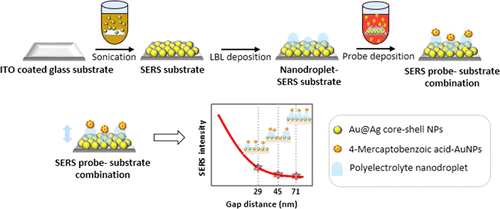Our official English website, www.x-mol.net, welcomes your
feedback! (Note: you will need to create a separate account there.)
Gap-Dependent Surface-Enhanced Raman Scattering (SERS) Enhancement Model of SERS Substrate–Probe Combination Using a Polyelectrolyte Nanodroplet as a Distance Controller
Langmuir ( IF 3.7 ) Pub Date : 2021-08-31 , DOI: 10.1021/acs.langmuir.1c01556 Kullavadee Karn-Orachai 1
Langmuir ( IF 3.7 ) Pub Date : 2021-08-31 , DOI: 10.1021/acs.langmuir.1c01556 Kullavadee Karn-Orachai 1
Affiliation

|
The development of surface-enhanced Raman scattering (SERS) biosensor platforms based on the sandwich combination of an SERS substrate and Raman reporter coated gold nanoparticle (AuNP) labeled with antibody has been widely performed for highly sensitive detection of biomolecules. The size of biomolecules located between these SERS-active materials dictates the sensitivity enhancement of the sensor. However, no suitable molecular size is provided. In this study, we report the gap-dependent SERS enhancement model using the combination of two SERS-active materials of 2D arrays of gold core–silver shell nanoparticles (Au@Ag core–shell NPs) as SERS-active substrates and mercaptobenzoic acid (MBA)-labeled AuNPs as SERS probes. The distance between these two materials is finely tuned using layer-by-layer assembled polyelectrolyte multilayer films. The morphology of the polyelectrolyte spacer is controlled into a droplet nanostructure, which is assumed to have a comparable shape with globular biomolecules. The well-controlled height or thickness of polyelectrolyte nanodroplet was achieved by changing number of deposition cycles. By increasing the thickness of the polyelectrolyte nanodroplet, MBA SERS intensities gradually decreased until at 40 nm-thick nanodroplet film and maintained afterward. This spacer thickness defined the limit of plasmonic coupling effect from this SERS probe–substrate combination. The SERS enhancement capability of this model was compared to conventional SERS immunoassay using three different antigen–antibody complex sizes of prostate-specific antigen, carcinoembryonic antigen, and carbohydrate antigen 19-9. Good agreement of the limitation of plasmon coupling as a function of the distance between the SERS substrate–probe combination using this developed model and SERS immunoassay was found. The finding provides valuable guidelines for immune-system selection in SERS immunosensors based on SERS substrate–probe combination.
中文翻译:

使用聚电解质纳米液滴作为距离控制器的 SERS 基底-探针组合的间隙相关表面增强拉曼散射 (SERS) 增强模型
表面增强拉曼散射 (SERS) 生物传感器平台的开发基于 SERS 基底和拉曼报告基因涂覆的用抗体标记的金纳米颗粒 (AuNP) 的夹心组合,已广泛用于生物分子的高灵敏度检测。位于这些 SERS 活性材料之间的生物分子的大小决定了传感器的灵敏度增强。然而,没有提供合适的分子大小。在这项研究中,我们报告了使用两种 SERS 活性材料的金核 - 银壳纳米粒子(Au@Ag 核 - 壳 NPs)二维阵列作为 SERS 活性底物和巯基苯甲酸的组合的间隙依赖性 SERS 增强模型。 MBA) 标记的 AuNP 作为 SERS 探针。这两种材料之间的距离使用逐层组装的聚电解质多层膜进行微调。聚电解质间隔物的形态被控制成液滴纳米结构,假设其具有与球状生物分子相当的形状。通过改变沉积循环次数来实现聚电解质纳米液滴的良好控制的高度或厚度。通过增加聚电解质纳米液滴的厚度,MBA SERS 强度逐渐降低,直到达到 40 nm 厚的纳米液滴膜并随后保持。这种间隔层厚度定义了这种 SERS 探针 - 基材组合的等离子体耦合效应的极限。将该模型的 SERS 增强能力与使用前列腺特异性抗原、癌胚抗原和碳水化合物抗原 19-9 三种不同抗原-抗体复合物大小的常规 SERS 免疫测定进行比较。发现等离子体耦合的限制作为使用该开发模型和 SERS 免疫测定的 SERS 底物-探针组合之间距离的函数的良好一致性。该发现为基于 SERS 底物-探针组合的 SERS 免疫传感器中的免疫系统选择提供了有价值的指导。
更新日期:2021-09-14
中文翻译:

使用聚电解质纳米液滴作为距离控制器的 SERS 基底-探针组合的间隙相关表面增强拉曼散射 (SERS) 增强模型
表面增强拉曼散射 (SERS) 生物传感器平台的开发基于 SERS 基底和拉曼报告基因涂覆的用抗体标记的金纳米颗粒 (AuNP) 的夹心组合,已广泛用于生物分子的高灵敏度检测。位于这些 SERS 活性材料之间的生物分子的大小决定了传感器的灵敏度增强。然而,没有提供合适的分子大小。在这项研究中,我们报告了使用两种 SERS 活性材料的金核 - 银壳纳米粒子(Au@Ag 核 - 壳 NPs)二维阵列作为 SERS 活性底物和巯基苯甲酸的组合的间隙依赖性 SERS 增强模型。 MBA) 标记的 AuNP 作为 SERS 探针。这两种材料之间的距离使用逐层组装的聚电解质多层膜进行微调。聚电解质间隔物的形态被控制成液滴纳米结构,假设其具有与球状生物分子相当的形状。通过改变沉积循环次数来实现聚电解质纳米液滴的良好控制的高度或厚度。通过增加聚电解质纳米液滴的厚度,MBA SERS 强度逐渐降低,直到达到 40 nm 厚的纳米液滴膜并随后保持。这种间隔层厚度定义了这种 SERS 探针 - 基材组合的等离子体耦合效应的极限。将该模型的 SERS 增强能力与使用前列腺特异性抗原、癌胚抗原和碳水化合物抗原 19-9 三种不同抗原-抗体复合物大小的常规 SERS 免疫测定进行比较。发现等离子体耦合的限制作为使用该开发模型和 SERS 免疫测定的 SERS 底物-探针组合之间距离的函数的良好一致性。该发现为基于 SERS 底物-探针组合的 SERS 免疫传感器中的免疫系统选择提供了有价值的指导。











































 京公网安备 11010802027423号
京公网安备 11010802027423号